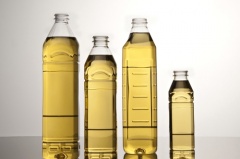Sunflower Oil
| Infobox on Sunflower Oil | |
|---|---|
| Example of Sunflower Oil |  |
| Facts | |
| Origin | This table shows only a selection of the most important countries of origin and should not be thought of as exhaustive.
|
| Density (in t/m3) |
|
| Temperature (in oC) |
Under normal transport conditions, sunflower oil is liquid and therefore need not be heated. It is resistant to cold, since it is free from wax, which has been previously filtered out. However, if extremely low temperatures should arise during the voyage which are in the solidification range, the oil has to be heated to prevent losses in quality and to achieve pumpability. The travel temperature must be complied with as far as possible during transport, to minimize oxidation processes. |
| Humidity / moisture | Fats and fatty oils are insoluble in water. However, contact with water may give rise to soluble lower fatty acids and glycerol, which cause rancidity together with changes in color (yellow to brown), odor and taste as well as gelling and thickening. For this reason, the tanks must be absolutely dry after cleaning. |
| Ventilation | Ventilation must not be carried out under any circumstances, as it would supply fresh oxygen to the cargo, which would promote oxidation processes and premature rancidity. |
| Self-heating / spontaneous combustion | - |
| Risk factors | The oil may ignite spontaneously in conjunction with sawdust or material residues. Sunflower oil is sensitive to foreign odors and contamination. Before anybody enters a tank, it must be ventilated and a gas measurement carried out. Oxidation processes may lead to a life-threatening shortage of O2. |
Sunflower Oil
Contents
Description
Sunflower oil is the non-volatile oil expressed from sunflower (Helianthus annuus) seeds. Sunflower oil is mainly triglycerides (fats), typically derived from the Fatty Acids linoleic acid (with is doubly unsaturated) and oleic acid. Sunflower oil has a pale yellow color and should have an acid value of at most 0,9 – 1,1%.
Several types of sunflower oils are produced, such as high linoleic, high oleic and mid oleic. Mid-linoleic sunflower oil typically has at least 69% linoleic acid. High oleic sunflower oil has at least 82% oleic acid. Variation in unsaturated fatty acids profile is strongly influenced by both genetics and climate.
Sunflower oil also contains lecithin, tocopherols, carotenoids and waxes. Sunflower oil's properties are typical of a vegetable triglyceride oil. Sunflower oil is produced from oil type Sunflower Seeds. Sunflower oil is light in taste and appearance and has a high vitamin E content. It is a combination of monounsaturated and polyunsaturated fats with low saturated fat levels.
Sunflower oil can be extracted using chemical solvents, or squeezed directly from sunflower seeds by crushing them in an expeller press. Cold pressing sunflower oil using an expeller press under low-temperature conditions is a preferred method for those seeking an extraction process that doesn't involve chemical solvents, as well as for people following a raw foods diet.
Refining sunflower oil through solvent extraction, degumming, neutralization and bleaching can make it more stable and suitable for high-temperature cooking, but will also remove some of the oil's nutrients and flavor, including color pigments, free Fatty Acids, phospholipids, polyphenols and phytosterols. Unrefined sunflower oil is less heat stable, but will retain more of its original nutrient content and flavor, and is well suited to dishes that require low- or no-heat.
Applications
Sunflower oil is commonly used in food as a frying oil, and in cosmetic formulations as an emollient.
Shipment / storage / usage
Because sunflower oil is primarily composed of healthier but less stable polyunsaturated and monounsaturated fatty acids, it can be particularly susceptible to damage by heat and light. Keeping sunflower oil at low temperatures both during processing and storage can help to minimize rancidity and nutrient loss, as can storage in darker amber-colored bottles.
Under normal transport conditions, sunflower oil is liquid and therefore need not be heated. It is resistant to cold, since it is free from wax, which has been previously filtered out. However, if extremely low temperatures should arise during the voyage which are in the solidification range, the oil has to be heated to prevent losses in quality and to achieve pumpability. The travel temperature must be complied with as far as possible during transport, to minimize oxidation processes.
| Travel temperature (favorable temperature range) | 15°C (5-26°C) |
| Solidification temperature | -16 - 18°C. |
| Pumping temperature | Approx. 15°C. |
Sunflower oil has no particular requirements as to storage climate conditions. The solidification temperature is of considerable significance in the transport of fatty oils and fats. They must remain liquid whilst in transit. Chill haze (separation) begins upon approaching the solidification point, whereby the oil becomes ointment-like and finally solid, such that it is no longer pumpable.
Separation and the associated change in consistency from liquid to solid occurs more readily upon cooling. The oils must only be heated by a few °C per day, otherwise the risk of rancidity and other negative changes arises.
In untreated sunflower oil certain substances may crystallise out in cold temperatures. This will lessen the value of the oil.
For further details on deterioration, contamination, oxidation, transit and handling etc., we may refer to Bulk Oils and Fats.
Risk factors
- Self heating / Spontaneous combustion
- Odor
- Contamination
- Mechanical influences
- Toxicity / Hazards to health
- Shrinkage / Shortage











